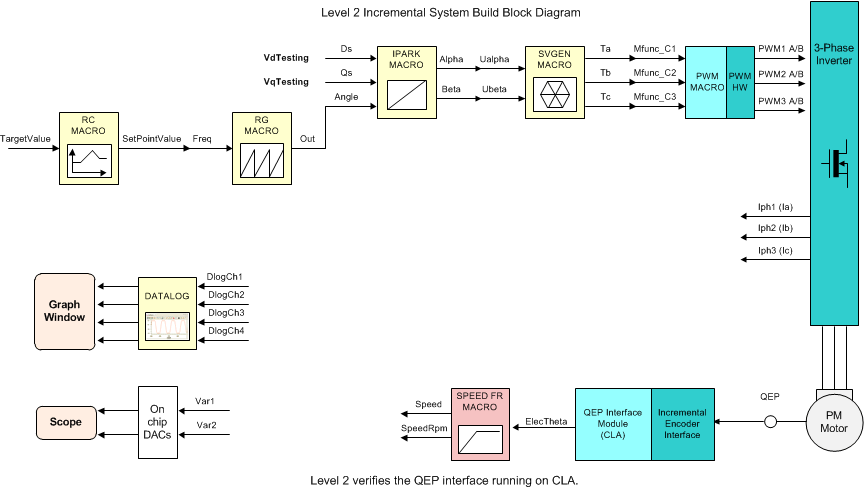SPRACM9B June 2019 – November 2020 TMS320F28384D , TMS320F28384S , TMS320F28386D , TMS320F28386S , TMS320F28388D , TMS320F28388S , TMS320F28P650DH , TMS320F28P650DK , TMS320F28P650SH , TMS320F28P650SK , TMS320F28P659DH-Q1 , TMS320F28P659DK-Q1 , TMS320F28P659SH-Q1
- Trademarks
- 1 Introduction
- 2 Benefits of the TMS320F2838x MCU for High-Bandwidth Current Loop
- 3 Current Loops in Servo Drives
- 4 Outline of the Fast Current Loop Library
- 5 Fast Current Loop Evaluation
- 6 Incremental Build Level 1
- 7 Incremental Build Level 2
- 8 Incremental Build Level 3
- 9 Incremental Build Level 4
- 10Incremental Build Level 5
- 11Incremental Build Level 6
- 12Incremental Build Level 7
- 13Incremental Build Level 8
- 14References
- 15Revision History
7 Incremental Build Level 2
Assuming build level 1 is completed successfully, this section verifies the overcurrent protection limits of the inverter and QEP interface running out of the CLA. In this build, the motor is run in open loop.
The motor can be connected to the HVDMC board because the PWM signals are successfully proven through the incremental build level 1.
- Open fcl_f2838x_tmdxiddk_settings_cpu1.h and select the level 2 incremental build option by setting the BUILDLEVEL to FCL_LEVEL2 (#define BUILDLEVEL FCL_LEVEL2).
- Select CURRENT_SENSE to LEM_CURRENT_SENSE
- Select POSITION_ENCODER to QEP_POS_ENCODER or T_FORMAT_ENCODER depending on the encoder coupled to motor.
- Right-click on the project name and click Rebuild Project.
- When the build is complete, click Debug, reset the CPU,
restart, enable real-time mode, and run.
Figure 7-1 shows the level 2 block diagram.
 Figure 7-1 Level 2 Block
Diagram
Figure 7-1 Level 2 Block
Diagram - Set enableFlag to 1 in the watch window. The variable
named isrTicker is incrementally increased as shown in the Expressions
window to confirm the interrupt is working properly. Now set the variable named
runMotor to MOTOR_RUN; the motor starts spinning after a few seconds
if enough voltage is applied to the DC-Bus.
In the software, the key variables to be adjusted are same as in previous level and are given again below for reference.- speedRef: for changing the rotor speed in per-unit
- VdTesting: for changing the d-axis voltage in per-unit
- VqTesting: for changing the q-axis voltage in per-unit
During the open loop tests, VqTesting, speedRef, and DC bus voltages must be adjusted carefully for PM motors so that the generated Bemf is lower than the average voltage applied to motor winding. This adjustment prevents the motor from stalling or vibrating.